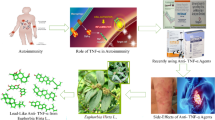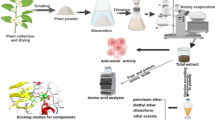Abstract
Molecular hybridization method was applied to design and synthesize a series of target compounds paeonol-based fibrate derivatives. The target compound was screened using a Triton WR-1339 induced hyperlipidemia mouse model, and compound T9 was found to have good lipid-lowering activity. The dose-dependent study of its lipid-lowering activity was also conducted. To further evaluate the lipid-lowering activity of compound T9, a hyperlipidemic mouse model induced by high fat emulsion can be used. The findings of the research illustrate that T9 is capable of significantly decreasing blood lipid levels, including TG, TC, LDL-C, and increasing HDL-C. The results of liver tissue oil red O staining and HE staining demonstrated that T9 improved the hepatic lipid accumulation, thus decreasing AST and ALT levels and protecting against hyperlipidemic liver injury. Studies into the lipid-lowering effect of T9 have indicated that it can upregulate PPAR-α protein expression in liver tissue, while simultaneously decreasing the expression of HMG-CoA protein. T9 was further demonstrated to possess antioxidant properties, as evidenced by an increase in SOD and a decrease in MDA, as well as anti-inflammatory effects, demonstrated by a decrease in TNF-α, IL-1β, and IL-6, thus confirming its potential as a hypolipidemia and hepatoprotective agent.
Graphical Abstract














Similar content being viewed by others
Abbreviations
- ALT:
-
alanine aminotransferase
- AST:
-
aspartate transaminase
- CF:
-
clofibrate
- 13C NMR:
-
13C-nuclear magnetic resonance
- DMAP:
-
4-Dimethylaminopyridine
- DMF:
-
N,N-dimethylformamide
- EDCI:
-
1-(3-dimethylaminopropyl) -3-ethylcarbodiimide
- MS:
-
mass spectrometry
- HDL-C:
-
high density lipoprotein cholesterol
- HMG-CoA:
-
hydroxymethylglutaryl coenzyme A
- 1H NMR:
-
1H-nuclear magnetic resonance
- IL-1β:
-
interleukin-1β
- IL-6:
-
interleukin-6
- LDL-C:
-
low density lipoprotein cholesterol
- MDA:
-
malondialdehyde
- PPAR-α:
-
peroxisome proliferator-activated receptor-α
- SOD:
-
superoxide dismutase
- TC:
-
total cholesterol
- TG:
-
triglycerides
- TNF-α:
-
tumor necrosis factor-α
References
Samuel VT, Shulman GI. The pathogenesis of insulin resistance: integrating signaling pathways and substrate flux. J Clin Investig. 2016;126:12–22. https://doi.org/10.1172/JCI77812.
Nelson RH. Hyperlipidemia as a risk factor for cardiovascular disease. Prim Care Clin Off Pract. 2013;40:195–211. https://doi.org/10.1016/j.pop.2012.11.003.
Bozkurt B, Aguilar D, Deswal A, Dunbar SB, Francis GS, Horwich T, et al. contributory risk and management of comorbidities of hypertension, obesity, diabetes mellitus, hyperlipidemia, and metabolic syndrome in chronic heart failure: a scientific statement from the American Heart Association. Circulation. 2016;134:e535–e578. https://doi.org/10.1161/CIR.0000000000000450.
Georgia-Eirini D, Athina S, Wim BV, Christos K, Theodoros C. Natural products from mediterranean diet: from anti-hyperlipidemic agents to dietary epigenetic modulators. Curr Pharm Biotechnol. 2019;20:825–44. https://doi.org/10.2174/1573407215666190628150921.
Farnier M, Zeller M, Masson D, Cottin Y. Triglycerides and risk of atherosclerotic cardiovascular disease: an update. Arch Cardiovasc Dis. 2021;114:132–9. https://doi.org/10.1016/j.acvd.2020.11.006.
Toth PP, Shah PK, Lepor NE. Targeting hypertriglyceridemia to mitigate cardiovascular risk: a review. Am J Prev Cardiol. 2020;3:100086. https://doi.org/10.1016/j.ajpc.2020.100086.
Wiesner P, Watson KE. Triglycerides: a reappraisal. Trends Cardiovasc Med. 2017;27:428–32. https://doi.org/10.1016/j.tcm.2017.03.004.
Nordestgaard BG, Varbo A. Triglycerides and cardiovascular disease. Lancet. 2014;384:626–35. https://doi.org/10.1016/S0140-6736(14)61177-6.
Bubb KJ, Nelson AJ, Nicholls SJ. Targeting triglycerides to lower residual cardiovascular risk. Expert Rev Cardiovasc Ther. 2022;20:185–91. https://doi.org/10.1080/14779072.2022.2058489.
Hassan RM, Aboutabl ME, Bozzi M, El-Behairy MF, El Kerdawy AM, Sampaolese B, et al. Discovery of 4-benzyloxy and 4-(2-phenylethoxy) chalcone fibrate hybrids as novel PPARα agonists with anti-hyperlipidemic and antioxidant activities: Design, synthesis and in vitro/in vivo biological evaluation. Bioorganic Chemistry. 2021;115. https://doi.org/10.1016/j.bioorg.2021.105170.
Hertz R, Bar-Tana J. Peroxisome proliferator-activated receptor (PPAR) alpha activation and its consequences in humans. Toxicol Lett. 1998;102–103:85–90. https://doi.org/10.1016/S0378-4274(98)00290-2.
Yamashita S, Rizzo M, Su TC, Masuda D. Novel selective PPARa Modulator Pemafibrate for Dyslipidemia, Nonalcoholic Fatty Liver Disease (NAFLD), and Atherosclerosis. Metabolites. 2023;13. https://doi.org/10.3390/metabo13050626.
Hedrington MS, Davis SN. Peroxisome proliferator-activated receptor alpha-mediated drug toxicity in the liver. Expert Opin Drug Metab Toxicol. 2018;14:671–7. https://doi.org/10.1080/17425255.2018.1483337.
Xie Y-D, Xu Y-H, Liu J-P, Wang B, Shi Y-H, Wang W, et al. 1,3-Benzodioxole-based fibrate derivatives as potential hypolipidemic and hepatoprotective agents. Bioorg Med Chem Lett. 2021;43:127898. https://doi.org/10.1016/j.bmcl.2021.127898.
Sierra ML, Beneton V, Boullay A-B, Boyer T, Brewster AG, Donche F, et al. Substituted 2-[(4-aminomethyl)phenoxy]-2-methylpropionic acid PPARα agonists.: 1.: discovery of a novel series of potent HDLc raising agents. J Med Chem. 2007;50:685–95. https://doi.org/10.1021/jm058056x.
Mokale SN, Elgire RD, Sakle N, Shinde DB. Synthesis, hypolipidemic and hypoglycemic activity of some novel 2-(4-(2-substituted aminothiazole-4-yl) phenoxy)-2-methyl propanoic acid derivatives. Bioorg Med Chem Lett. 2011;21:682–5. https://doi.org/10.1016/j.bmcl.2010.12.011.
Sashidhara KV, Kumar M, Sonkar R, Singh BS, Khanna AK, Bhatia G. Indole-based fibrates as potential hypolipidemic and antiobesity agents. J Med Chem. 2012;55:2769–79. https://doi.org/10.1021/jm201697v.
Pawelczyk A, Sowa-Kasprzak K, Olender D, Zaprutko L. Molecular consortia-various structural and synthetic concepts for more effective therapeutics synthesis. Int J Mol Sci. 2018;19. https://doi.org/10.3390/ijms19041104.
Davison EK, Brimble MA. Natural product derived privileged scaffolds in drug discovery. Curr Opin Chem Biol. 2019;52:1–8. https://doi.org/10.1016/j.cbpa.2018.12.07.
Zhang L, Li DC, Lin LF. Paeonol: pharmacological effects and mechanisms of action. Int Immunopharmacol. 2019;72:413–21. https://doi.org/10.1016/j.intimp.2019.04.033.
Zhou A, Wu HF, Pan J, Wang XC, Li JM, Wu ZY, et al. Synthesis and evaluation of paeonol derivatives as potential multifunctional agents for the treatment of Alzheimer’s disease. Molecules. 2015;20:1304–18. https://doi.org/10.3390/molecules20011304.
Li L, Su XL, Bai TT, Qin W, Li AH, Liu YX, et al. New paeonol derivative C302 reduces hypertension in spontaneously hypertensive rats through endothelium-dependent and endothelium-independent vasodilation. European Journal of Pharmacology. 2022;927. https://doi.org/10.1016/j.ejphar.2022.175057.
Ibrahim A, Shafie NH, Esa NM, Shafie SR, Bahari H, Abdullah MA. Mikania micrantha extract inhibits HMG-CoA reductase and ACAT2 and ameliorates hypercholesterolemia and lipid peroxidation in high cholesterol-fed rats. Nutrients. 2020;12:3077. https://doi.org/10.3390/nu12103077.
Furue K, Mitoma C, Tsuji G, Furue M. Protective role of peroxisome proliferator-activated receptor α agonists in skin barrier and inflammation. Immunobiology. 2018;223:327–30. https://doi.org/10.1016/j.imbio.2017.10.047.
Shen BY, Wang YL, Cheng JQ, Peng Y, Zhang QL, Li Z, et al. Pterostilbene alleviated NAFLD via AMPK/mTOR signaling pathways and autophagy by promoting Nrf2. Phytomedicine. 2023;109. https://doi.org/10.1016/j.phymed.2022.154561.
Adkins Y, Kelley DS. Mechanisms underlying the cardioprotective effects of omega-3 polyunsaturated fatty acids. J Nutr Biochem. 2010;21:781–92. https://doi.org/10.1016/j.jnutbio.2009.12.004.
Gallucci GM, Alsuwayt B, Auclair AM, Boyer JL, Assis DN, Ghonem NS. Fenofibrate downregulates NF-κB signaling to inhibit pro-inflammatory cytokine secretion in human THP-1 macrophages and during primary biliary cholangitis. Inflammation. 2022;45:2570–81. https://doi.org/10.1007/s10753-022-01713-1.
Westergaard M, Henningsen J, Johansen C, Rasmussen S, Svendsen ML, Jensen UB, et al. Expression and localization of peroxisome proliferator-activated receptors and nuclear factor κB in normal and lesional psoriatic skin. J Investig Dermatol. 2003;121:1104–17. https://doi.org/10.1046/j.1523-1747.2003.12536.x.
Tian B, Zhang SW, Li QY, Sun CY, Wu YN, Yang HR, et al. Effect of the combination of cognitive behavioral therapy and oral paroxetine hydrochloride in patients with post-stroke depression. Trop J Pharm Res. 2022;21:1993–2000. https://doi.org/10.4314/tjpr.v21i9.25.
Song KH, Lee SH, Kim BY, Park AY, Kim JY. Extracts of Scutellaria baicalensis reduced body weight and blood triglyceride in db/db mice. Phytother Res. 2013;27:244–50. https://doi.org/10.1002/ptr.4691.
Alvarez-Jimenez L, Moreno-Cabañas A, Ramirez-Jimenez M, Morales-Palomo F, Ortega JF, Mora-Rodriguez R. Effectiveness of statins vs. exercise on reducing postprandial hypertriglyceridemia in dyslipidemic population: a systematic review and network meta-analysis. J Sport Health Sci. 2022;11:567–77. https://doi.org/10.1016/j.jshs.2021.07.006.
Si SC, Hou L, Chen XL, Li WC, Liu XH, Liu CC, et al. Exploring the causal roles of circulating remnant lipid profile on cardiovascular and cerebrovascular diseases: mendelian randomization study. J Epidemiol. 2022;32:205–14. https://doi.org/10.2188/jea.JE20200305.
Khan S, Chavez J, Zhu XW, Chiu NHL, Zhang WD, Yin ZY, et al. Carbon Nanodots Inhibit Oxidized Low Density Lipoprotein-Induced Injury and Monocyte Adhesion to Endothelial Cells Through Scavenging Reactive Oxygen Species. J Biomed Nanotechnol. 2021;17:1654–67. https://doi.org/10.1166/jbn.2021.3125.
Zhang QB, Chen LM, Si ZH, Bu HR, Narasimhulu CA, Song XL, et al. Probucol protects endothelial progenitor cells against oxidized low-density lipoprotein via suppression of reactive oxygen species formation in vivo. Cell Physiol Biochem. 2016;39:89–101. https://doi.org/10.1159/000445608.
Ratheesh M, Svenia JP, Asha S, Sandya S, Girishkumar B, Krishnakumar IM. Anti-inflammatory effect of a novel formulation of coconut inflorescence sap against ox-LDL induced inflammatory responses in human peripheral blood mononuclear cells by modulating TLR-NF-κB signaling pathway. Toxicol Mech Methods. 2017;27:615–21. https://doi.org/10.1080/15376516.2017.1344339.
Saji S, Asha S, Svenia PJ, Ratheesh M, Sheethal S, Sandya S, et al. Curcumin-galactomannoside complex inhibits pathogenesis in Ox-LDL-challenged human peripheral blood mononuclear cells. Inflammopharmacology. 2018;26:1273–82. https://doi.org/10.1007/s10787-018-0474-0.
Hsu DZ, Chen KT, Chien SP, Li YH, Huang BM, Chuang YC, et al. Sesame oil attenuates acute iron-induced lipid peroxidation-associated hepatic damage in mice. Shock. 2006;26:625–30. https://doi.org/10.1097/01.shk.0000232274.88354.8d.
Chen YL, Zong CL, Guo YX, Tian L. Hydrogen-rich saline may be an effective and specific novel treatment for osteoradionecrosis of the jaw. Ther Clin Risk Manag. 2015;11:1581–5. https://doi.org/10.2147/TCRM.S90770.
El-Desoky AH, Abdel-Rahman RF, Ahmed OK, El-Beltagi HS, Hattori M. Anti-inflammatory and antioxidant activities of naringin isolated from Carissa carandas L.: in vitro and in vivo evidence. Phytomedicine. 2018;42:126–34. https://doi.org/10.1016/j.phymed.2018.03.051.
Debbache-Benaida N, Atmani-Kilani D, Schini-Keirth VB, Djebbli N, Atmani D. Pharmacological potential of Populus nigra extract as antioxidant, antiinflammatory, cardiovascular and hepatoprotective agent. Asian Pac J Trop Biomed. 2013;3:697–704. https://doi.org/10.1016/S2221-1691(13)60141-0.
Thitimuta S, Pithayanukul P, Nithitanakool S, Bavovada R, Leanpolchareanchai J, Saparpakorn P Camellia sinensis L. Extract and its potential beneficial effects in antioxidant, anti-inflammatory, anti-hepatotoxic, and anti-tyrosinase activities. Molecules. 2017;22. https://doi.org/10.3390/molecules22030401.
Zhang L, Ren F, Zhang XY, Wang XX, Shi HB, Zhou L, et al. Peroxisome proliferator-activated receptor alpha acts as a mediator of endoplasmic reticulum stress-induced hepatocyte apoptosis in acute liver failure. Dis Models Mech. 2016;9:799–809. https://doi.org/10.1242/dmm.023242.
Das M, Geetha V, Zarei M, Harohally NV, Kumar GS. Modulation of obesity associated metabolic dysfunction by novel lipophilic fraction obtained from Agaricus bisporus. Life Sci. 2022;305:120779. https://doi.org/10.1016/j.lfs.2022.120779.
Zarzecki MS, Araujo SM, Bortolotto VC, de Paula MT, Jesse CR, Prigol M. Hypolipidemic action of chrysin on Triton WR-1339-induced hyperlipidemia in female C57BL/6 mice. Toxicol Rep. 2014;1:200–8. https://doi.org/10.1016/j.toxrep.2014.02.003.
Lei F, Zhang XN, Wang W, Xing DM, Xie WD, Su H, et al. Evidence of anti-obesity effects of the pomegranate leaf extract in high-fat diet induced obese mice. Int J Obes. 2007;31:1023–9. https://doi.org/10.1038/sj.ijo.0803502.
Zhuang SY, Wu ML, Wei PJ, Cao ZP, Xiao P, Li CH. Changes in plasma lipid levels and antioxidant activities in rats after supplementation of obtusifolin. Planta Med. 2016;82:539–43. https://doi.org/10.1055/s-0042-102458.
Acknowledgements
This study was supported by Shaanxi University of Traditional Chinese Medicine Student Innovation and Entrepreneurship Training Program Project (No. 202210716107). Sci-Tech Innovation Talent System Construction Program of Shaanxi University of Chinese Medicine (No. 2023-CXTD-05). Shaanxi Special Support Plan Talent Project. Shaanxi Provincial Administration of Traditional Chinese Medicine “Double Chain Integration” Young and middle-aged Scientific Research and Innovation Team Project (No. 2022-SLRH-YQ-008). Shaanxi Province key research and development plan project (No. 2024SF-YBXM-496).
Author information
Authors and Affiliations
Corresponding authors
Ethics declarations
Conflict of interest
The authors declare no competing interests.
Additional information
Publisher’s note Springer Nature remains neutral with regard to jurisdictional claims in published maps and institutional affiliations.
Supplementary information
Rights and permissions
Springer Nature or its licensor (e.g. a society or other partner) holds exclusive rights to this article under a publishing agreement with the author(s) or other rightsholder(s); author self-archiving of the accepted manuscript version of this article is solely governed by the terms of such publishing agreement and applicable law.
About this article
Cite this article
Quan, L., Guo, Y., Wang, S. et al. Molecular hybridization method for obtaining paeonol-based fibrate derivatives with potent lipid-lowering and hepatoprotective activity. Med Chem Res 33, 796–810 (2024). https://doi.org/10.1007/s00044-024-03214-2
Received:
Accepted:
Published:
Issue Date:
DOI: https://doi.org/10.1007/s00044-024-03214-2




